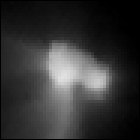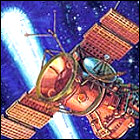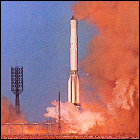Vega 2 visits Halley
 The Soviet Union’s unmanned space probe Vega 2 makes its closest approach to the nucleus of Halley’s Comet, within 5,000 miles of the comet’s icy core. Hundreds of photos are taken and transmitted back to Earth, along with analysis of the dust and gas surrounding the comet. Within a week, Vega 2’s mission is complete, and the probe is allowed to fall into an orbit around the sun as Halley continues to speed back toward the outer solar system.
The Soviet Union’s unmanned space probe Vega 2 makes its closest approach to the nucleus of Halley’s Comet, within 5,000 miles of the comet’s icy core. Hundreds of photos are taken and transmitted back to Earth, along with analysis of the dust and gas surrounding the comet. Within a week, Vega 2’s mission is complete, and the probe is allowed to fall into an orbit around the sun as Halley continues to speed back toward the outer solar system.
Vega 1 visits Halley
 The Soviet Union’s unmanned space probe Vega 1 makes its closest approach to the nucleus of Halley’s Comet, a little over 5,000 miles away (a closer flight path is taken by its twin, Vega 2). Information gathered in the earliest stages of the encounter is shared with the European Space Agency, whose Giotto unmanned probe will make a much closer examination of Halley. Vega 1 registers an immense number of impacts from dust particles, but sustains no serious damage in close proximity to the comet; after several days of observations, Vega 1 is allowed to fall into an orbit around the sun.
The Soviet Union’s unmanned space probe Vega 1 makes its closest approach to the nucleus of Halley’s Comet, a little over 5,000 miles away (a closer flight path is taken by its twin, Vega 2). Information gathered in the earliest stages of the encounter is shared with the European Space Agency, whose Giotto unmanned probe will make a much closer examination of Halley. Vega 1 registers an immense number of impacts from dust particles, but sustains no serious damage in close proximity to the comet; after several days of observations, Vega 1 is allowed to fall into an orbit around the sun.
Vega 2 visits Venus
 The landing module of the Vega 2 unmanned space probe successfully lands on Venus, gathering and analyzing soil samples and transmitting its findings back to Earth before the heat and atmospheric pressure destroy it within an hour. The terrain it lands on is found to be composed of rock resembling the surface of Earth’s moon. The Vega 2 “mothership” continues past Venus, en route to a rendezvous with Halley’s Comet.
The landing module of the Vega 2 unmanned space probe successfully lands on Venus, gathering and analyzing soil samples and transmitting its findings back to Earth before the heat and atmospheric pressure destroy it within an hour. The terrain it lands on is found to be composed of rock resembling the surface of Earth’s moon. The Vega 2 “mothership” continues past Venus, en route to a rendezvous with Halley’s Comet.
Vega 1 visits Venus
 The landing module of the Vega 1 unmanned space probe arrives at the planet Venus, though some of its on-board experiment packages activate during descent, rather than activating after contact with the surface, and little data is returned. Thanks to a gravity assist from a close flyby of Venus, the Vega 1 “mothership” continues past the planet toward a 1986 rendezvous with Halley’s Comet.
The landing module of the Vega 1 unmanned space probe arrives at the planet Venus, though some of its on-board experiment packages activate during descent, rather than activating after contact with the surface, and little data is returned. Thanks to a gravity assist from a close flyby of Venus, the Vega 1 “mothership” continues past the planet toward a 1986 rendezvous with Halley’s Comet.
Vega 2 launched
 Just days after its twin lifts off, the unmanned Vega 2 space probe is launched by the Soviet Union on a dual mission to drop off a lander at Venus and then to intercept Halley’s Comet in 1986. Derived from the USSR’s earlier Venera Venus landers, Vega 2 will test a refined landing system for landing on Venus by balloon, and will then join an international fleet of unmanned spacecraft attempting to take advantage of Halley’s visit to the inner solar system in late 1985 and early 1986.
Just days after its twin lifts off, the unmanned Vega 2 space probe is launched by the Soviet Union on a dual mission to drop off a lander at Venus and then to intercept Halley’s Comet in 1986. Derived from the USSR’s earlier Venera Venus landers, Vega 2 will test a refined landing system for landing on Venus by balloon, and will then join an international fleet of unmanned spacecraft attempting to take advantage of Halley’s visit to the inner solar system in late 1985 and early 1986.
Vega 1 launched
 The unmanned Vega 1 space probe is launched by the Soviet Union on a dual mission to drop off a lander at Venus and then to intercept Halley’s Comet in 1986. Derived from the USSR’s earlier Venera Venus landers, Vega will test a refined landing system for landing on Venus by balloon, and will then join an international fleet of unmanned spacecraft attempting to take advantage of Halley’s visit to the inner solar system in late 1985 and early 1986.
The unmanned Vega 1 space probe is launched by the Soviet Union on a dual mission to drop off a lander at Venus and then to intercept Halley’s Comet in 1986. Derived from the USSR’s earlier Venera Venus landers, Vega will test a refined landing system for landing on Venus by balloon, and will then join an international fleet of unmanned spacecraft attempting to take advantage of Halley’s visit to the inner solar system in late 1985 and early 1986.